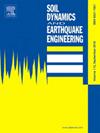The combined amplification effects of topography and stratigraphy of layered rock slopes under vertically and obliquely incident seismic waves
IF 4.2
2区 工程技术
Q1 ENGINEERING, GEOLOGICAL
引用次数: 0
Abstract
Both the topography and stratigraphy of slopes significantly affect the ground motions of slopes during earthquakes, and oblique incidence of seismic waves can further aggravate amplification. This study aims to parametrically explore the combined effects of the topography and stratigraphy of layered rock slopes on seismic amplification subjected to vertical and oblique propagating waves and provide qualitative and quantitative insight into this phenomenon. The spectral element method used to obtain the seismic response of slopes is introduced and verified by two examples. The influences of the slope angle, material properties of the layers, surface layer conditions, and incident angle of the seismic waves on the seismic amplification are then investigated. The results indicate that the peak horizontal and vertical amplification factors for layered rock slopes subjected to vertical and oblique incidence of seismic waves are in the ranges of 1.3–7.6 and 0.3–5.2, respectively. Among the various factors, the thickness and shear wave velocity of the surface layer of slopes have the greatest influence on the amplification effect, especially for obliquely incident waves. At oblique incidence, the maximum horizontal and vertical normalized acceleration amplification factors for the soft-surface-layer slope are 4.4 and 7.4 times greater than those for the hard-surface cases, respectively, whereas at vertical incidence, these values are only 2.8 and 4.3, respectively. When the impedance ratio between the surface layer and the underlying layer is 0.5 (i.e., the soft surface layer), unusual vertical amplification is observed where the maximum vertical amplification factor reaches 5.2. The findings of this study may provide useful reference and guidance for the seismic design of slope engineering and building structures near slopes.
求助全文
约1分钟内获得全文
求助全文
来源期刊

Soil Dynamics and Earthquake Engineering
工程技术-地球科学综合
CiteScore
7.50
自引率
15.00%
发文量
446
审稿时长
8 months
期刊介绍:
The journal aims to encourage and enhance the role of mechanics and other disciplines as they relate to earthquake engineering by providing opportunities for the publication of the work of applied mathematicians, engineers and other applied scientists involved in solving problems closely related to the field of earthquake engineering and geotechnical earthquake engineering.
Emphasis is placed on new concepts and techniques, but case histories will also be published if they enhance the presentation and understanding of new technical concepts.
 求助内容:
求助内容: 应助结果提醒方式:
应助结果提醒方式:


